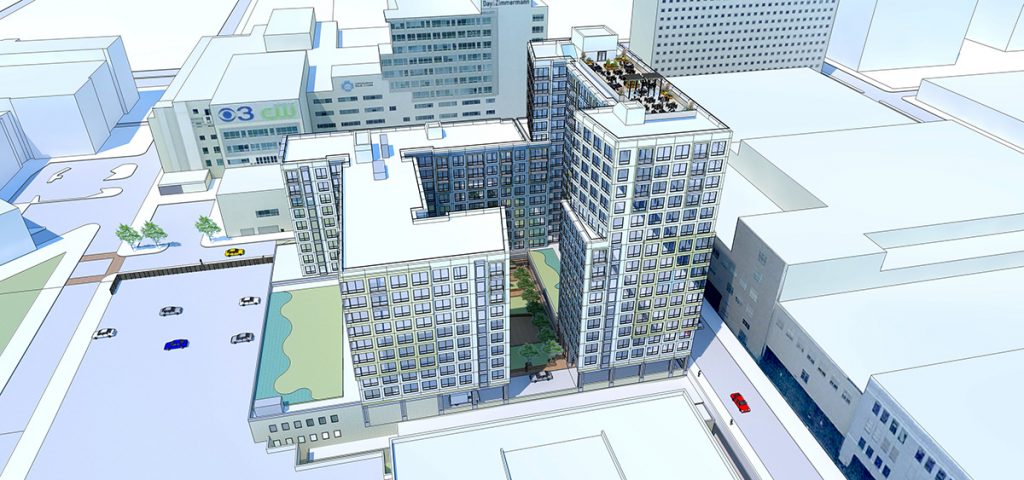Industrial Buildings Are Not A Long – Term Answer For Philly’s Multifamily Market

Construction costs and the late stage of a development cycle make for a tough environment for multifamily construction in Philadelphia. Industrial-to-multifamily conversions have made for a cheaper, trendy alternative, but they are a finite resource that may be running out.
Current projects around North Broad Street, like Radnor Property Group’s The Hamilton and PRDC’s Heid building, will add to the list of multifamily conversions in the belt just north of Center City that once was filled with industrial buildings. But according to Logan Square Neighborhood Association President Drew Murray, the Hamilton may be the last industrial site to convert between Market Street and Spring Garden Avenue, Broad Street and the Schuylkill River. It was the only site to be changed from industrial to mixed-use in the last rezoning cycle.
“In general, there are few and far between open-air lots left in our neighborhood, and even fewer industrial buildings,” Murray said.
The area on the other side of North Broad Street, mostly made up of the Callowhill neighborhood and what is being dubbed Spring Arts, does have some industrial properties that fit the bill, but the farther a property is from the North Broad corridor, the less pedestrian activity surrounds it. Without pedestrian activity in place, a multifamily building can be a tricky proposition.
“When you look at long corridors that perhaps have not seen redevelopment opportunities, like the eastern stretch of Callowhill, there are a lot of buildings down there that could be ripe for retrofit, but aren’t necessarily infill locations,” Radnor Property Group founder David Yeager said. “Infill locations are less of a gamble, because the intrinsic benefits are already there.”
It seems all but a foregone conclusion that development will come to Callowhill; it is positioned too well between Broad Street, Center City and Northern Liberties to remain the hole in the doughnut. But whoever is first in the area will need to be savvy.
“If someone was jumping right into the middle of that whole Spring Arts area and there was nothing around it, I don’t know,” Cross Properties partner Bobby Fijan said. “A lot of these projects are about good partnerships with the right kind of retailer, so the right project can be a beacon in the area, but it has to be really well curated.”
For the first few North Broad Street projects to be completed, Marc Vetri restaurants Osteria and Alla Spina brought diners to the area. Once the Hamilton, the Heid building and the other projects in the area are finished, it could be a vibrant corridor stretching all the way from Center City.
“I don’t know what kind of uses would go into Spring Arts, but in general, great restaurants are a draw, and the right one puts the seal of approval on the area,” Fijan said. “Say, if Stephen Starr opened up a restaurant, I would go to Spring Arts, and I know plenty of people would.”
Beyond Callowhill and Spring Arts, very few areas provide the combination of industrial buildings and density that make conversions enticing. There are some potential sites north of Penn Treaty Park on Delaware Avenue, but the wide roadway and I-95 entrance sequester that portion of the Delaware River waterfront from Fishtown. South of University City, around Pennovation Works, has more potential, but that is years down the road.
“Within the confines of [the Pennovation] redevelopment, [Penn is] creating incubators and smaller companies that are focused on growth,” Yeager said. “I think it’ll also draw an interest in multifamily housing around it.”
Areas like Kensington, north along the Market-Frankford Line, would also make sense for industrial conversions, but not for years.
“If development keeps going north, the way it’s marching from NoLibs to Fishtown and Port Richmond, there are industrial areas in that part of the city, but the value needs to make its way there before those are in line to be converted,” Fijan said.
The question of industrial-to-multifamily’s long-term potential is not as simple as finding the right area. While the right building can be significantly cheaper to redevelop than new construction, not every former warehouse or manufacturing facility is as narrow as the Quaker Building that Post Brothers is targeting.
“I would consider [industrial buildings] to be a dwindling resource, particularly the types of buildings that can be converted,” Fijan said. “The building can’t have gone into disrepair — it needs to be structurally sound — and it needs to have the structure that is conducive to multifamily.”
Many have deep profiles and wide hallways that severely cut down on the amount of rentable space, or even deeper concerns tied to a building’s industrial history.
“The sorts of things that are unforeseen conditions below ground, like abandoned oil tanks or polluted soil and groundwater,” Yeager said. “That’s the first thing you have to be concerned about.”
The Hamilton avoided those issues because the existing structure already had below-ground space, rendering further excavation unnecessary. Even so, any developer purchasing an old industrial building for a conversion is making a gamble.
“It really is a risk, because you can undertake as much preliminary environmental investigation as you can, but until you start peeling away at the structure itself to retrofit it, you’ll often find surprises like asbestos behind walls or lead contaminants,” Yeager said. “There are all these unforeseen conditions that hopefully every developer is budgeting for.”
All these challenges dim the luster of industrial buildings as a workaround for new construction in Philadelphia. They have produced some hallmark developments in the city over the past few years, but there does not seem to be enough of them to provide a sustainable source of multifamily units in the near future. Once again, there are no easy answers to developing apartment buildings in Philly.